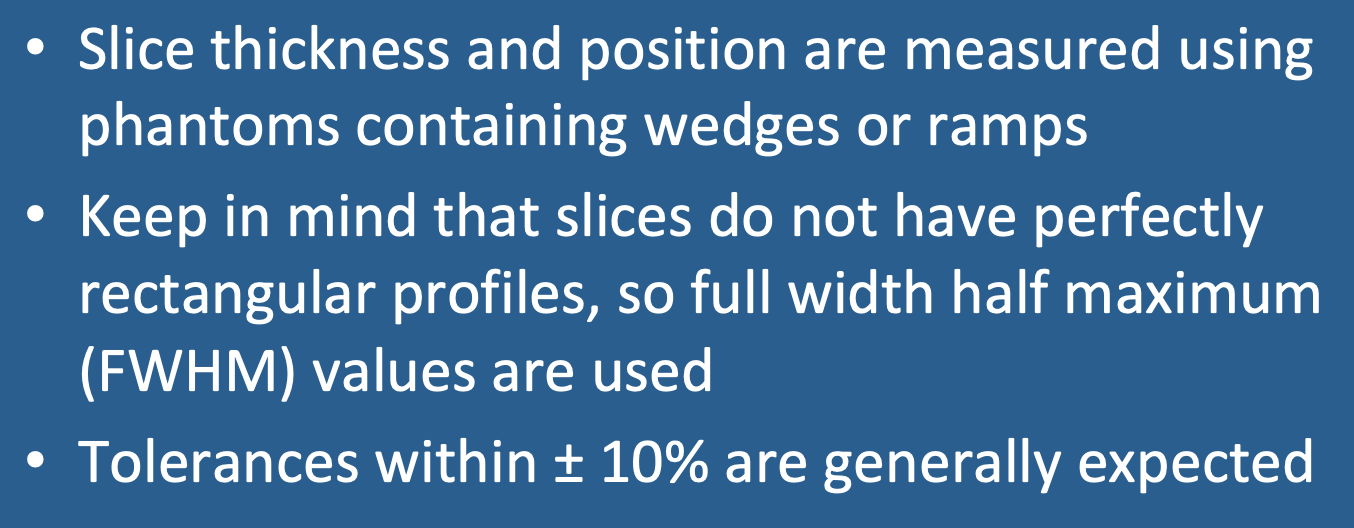Two types of image resolution are generally distinguished and tested: high-contrast and low-contrast. High-contrast resolution is the ability to detect finely spaced lines or holes with whose signals differ considerably from background. Low-contrast resolution is the ability to detect and discern objects with only subtle differences in signal intensity. Again, organizations like the American College of Radiology (ACR) and American Association of Physicists in Medicine (AAPM) publish detailed procedures for measuring these properties.
High Contrast Resolution
|
The high-contrast portion of MR phantoms contains closely spaced lines, edges, or holes containing material with strong differences in signal intensity from background.
The ACR phantom insert pictured above left has holes 0.9 - 1.1 mm diameter spaced 1.0 mm apart. When scanned with a technique having in-plane pixel size of 1 mm x 1 mm the holes in the middle set should all be resolved.
Phantoms with parallel or diverging bars allow describing spatial resolution in terms of line pairs per mm. Measuring pixel intensities along the edge of sharp boundaries (such as the large black squares) allows calculation of the Line Spread Function (LSF), an analog of the Modulation Transfer Function (MTF) used in CT.
|
Causes of poor high-contrast spatial resolution include excessive image filtering by software, eddy currents, ghosting, and geometric errors.
Low contrast Object Detectability
Low-contrast resolution refers to the ability to identify small objects with only slightly different relaxation times from background. The ACR phantom uses a series of disks with small holes arranged as a circle of 10 spokes. A score is assigned based on the number of complete spokes identified.
 Images from four slices of the low-contrast part of the ACR phantom with decreases in number of perceived holes/spokes as the image contrast progressively decreases from 5.1% to 1.0% (left to right)
Images from four slices of the low-contrast part of the ACR phantom with decreases in number of perceived holes/spokes as the image contrast progressively decreases from 5.1% to 1.0% (left to right)
Advanced Discussion (show/hide)»
The most accurate methods for slice thickness measurements are well-described in the accompanying link to NEMA MS 5. Ideally two ramps or wedges should be used and corrections made for their slight misalignment or rotation. Determining the FWHM from the “shadow” image” of the phantom is not trivial. An edge response function (ERF) of signal intensity is first obtained, then differentiated with respect to position to obtain slice profile and FWHM.
References
American Association of Physicists in Medicine (AAPM). Report No.100. Acceptance testing and quality assurance procedures for magnetic resonance imaging facilities. 2010.
American College of Radiology. Phantom test guidance for use of the large MRI phantom for the ACR accreditation program, 2018.
National Electrical Manufacturers Association. NEMA Standards Publication MS 5-2008 (R2014). Determination of slice thickness in diagnostic magnetic resonance imaging. NEMA, Washington, DC. Can be downloaded for free or purchased in book form here.
American Association of Physicists in Medicine (AAPM). Report No.100. Acceptance testing and quality assurance procedures for magnetic resonance imaging facilities. 2010.
American College of Radiology. Phantom test guidance for use of the large MRI phantom for the ACR accreditation program, 2018.
National Electrical Manufacturers Association. NEMA Standards Publication MS 5-2008 (R2014). Determination of slice thickness in diagnostic magnetic resonance imaging. NEMA, Washington, DC. Can be downloaded for free or purchased in book form here.
Related Questions
What types of routine quality control must be performed on an MR scanner?
What is cross-talk and what can be done about it?
What types of routine quality control must be performed on an MR scanner?
What is cross-talk and what can be done about it?


